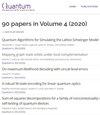Unstructured Adiabatic Quantum Optimization: Optimality with Limitations
IF 5.1
2区 物理与天体物理
Q1 PHYSICS, MULTIDISCIPLINARY
引用次数: 0
Abstract
In the circuit model of quantum computing, amplitude amplification techniques can be used to find solutions to NP-hard problems defined on $n$-bits in time $\text{poly}(n) 2^{n/2}$. In this work, we investigate whether such general statements can be made for adiabatic quantum optimization, as provable results regarding its performance are mostly unknown. Although a lower bound of $\Omega(2^{n/2})$ has existed in such a setting for over a decade, a purely adiabatic algorithm with this running time has been absent. We show that adiabatic quantum optimization using an unstructured search approach results in a running time that matches this lower bound (up to a polylogarithmic factor) for a broad class of classical local spin Hamiltonians. For this, it is necessary to bound the spectral gap throughout the adiabatic evolution and compute beforehand the position of the avoided crossing with sufficient precision so as to adapt the adiabatic schedule accordingly. However, we show that the position of the avoided crossing is approximately given by a quantity that depends on the degeneracies and inverse gaps of the problem Hamiltonian and is NP-hard to compute even within a low additive precision. Furthermore, computing it exactly (or nearly exactly) is #P-hard. Our work indicates a possible limitation of adiabatic quantum optimization algorithms, leaving open the question of whether provable Grover-like speed-ups can be obtained for any optimization problem using this approach.非结构绝热量子优化:有限制的最优性
在量子计算的电路模型中,振幅放大技术可用于求解在时间$\text{poly}(n) 2^{n/2}$ n位上定义的np困难问题。在这项工作中,我们研究是否可以对绝热量子优化做出这样的一般陈述,因为关于其性能的可证明结果大多是未知的。虽然$\Omega(2^{n/2})$的下界已经在这样的设置中存在了十多年,但没有一个具有这种运行时间的纯绝热算法。我们表明,使用非结构化搜索方法的绝热量子优化导致的运行时间与广泛的经典局部自旋哈密顿量的下界(直到多对数因子)相匹配。为此,有必要在整个绝热演化过程中对谱隙进行限定,并事先以足够的精度计算避免交叉的位置,从而相应地调整绝热调度。然而,我们证明了避免交叉的位置是由一个依赖于问题哈密顿量的简并性和逆间隙的量近似给出的,并且即使在低加性精度下也难以计算。此外,精确地(或几乎精确地)计算它是#P-hard。我们的工作表明了绝热量子优化算法的可能局限性,留下了一个问题,即使用这种方法是否可以为任何优化问题获得可证明的类格罗弗加速。
本文章由计算机程序翻译,如有差异,请以英文原文为准。
求助全文
约1分钟内获得全文
求助全文
来源期刊

Quantum
Physics and Astronomy-Physics and Astronomy (miscellaneous)
CiteScore
9.20
自引率
10.90%
发文量
241
审稿时长
16 weeks
期刊介绍:
Quantum is an open-access peer-reviewed journal for quantum science and related fields. Quantum is non-profit and community-run: an effort by researchers and for researchers to make science more open and publishing more transparent and efficient.
 求助内容:
求助内容: 应助结果提醒方式:
应助结果提醒方式:


